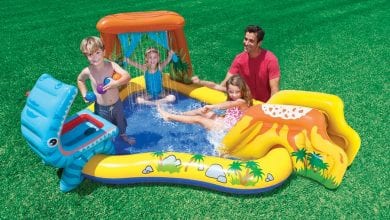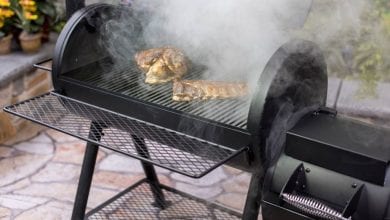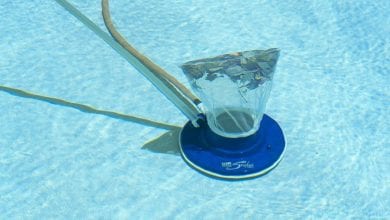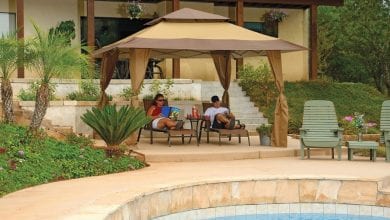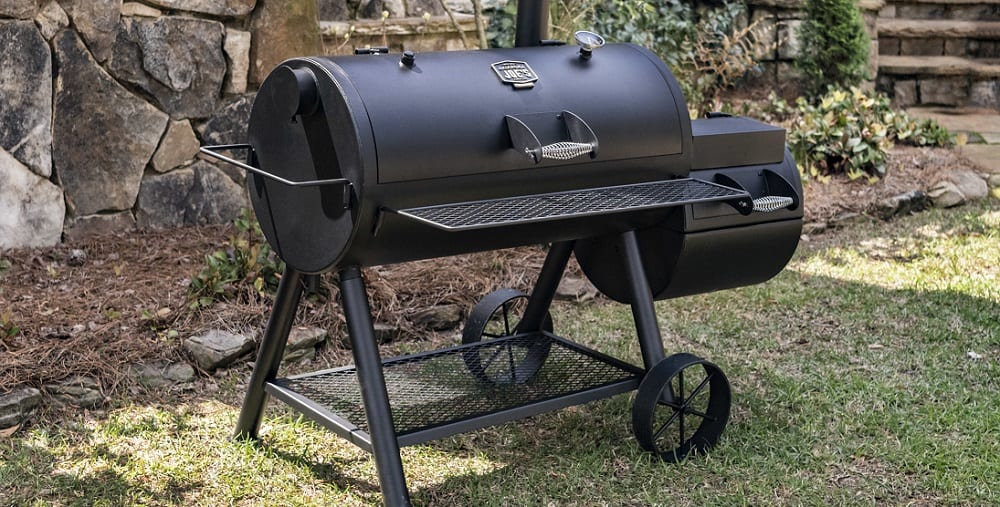
Although some people might not understand the difference between offset smokers and reverse flow ones, the difference between the two isn’t that drastic. Reverse flow smoker uses a metal baffle and a smokestack on the firebox side of the unit to force the smoke to pass all over the meat in the smoker before it exits the unit. It’s this simple innovation that helps to prevent the meat from being overcooked and helps expose it to more smoke. It’s the reason why the consumer should take the time to purchase the best reverse flow smoker they can find and put it to work in their home.
Quick Summary of Best Reverse Flow Smokers



Reviews
Editor’s Choice: Oklahoma Joe’s Longhorn Smoker
 One of the best reverse flow smokers that we’ve reviewed thus far is this model from Oklahoma Joes. This model is called the Longhorn, and it has all of the features that we could want out of one of these smokers. Not only does it have a series of four baffles that direct heat and smoke through the unit for an indirect cooking/smoking process, but it also has a smokestack that can be moved from one side to the other for the best results.
One of the best reverse flow smokers that we’ve reviewed thus far is this model from Oklahoma Joes. This model is called the Longhorn, and it has all of the features that we could want out of one of these smokers. Not only does it have a series of four baffles that direct heat and smoke through the unit for an indirect cooking/smoking process, but it also has a smokestack that can be moved from one side to the other for the best results.
This product is approximately 35-inches by 64-inches by 55-inches and weighs approximately 226-pounds. This model is made out of heavy gauge steel and is equipped with porcelain-coated cooking grates that allow for even cooking. This model has a rack on the front of it for prep space, and a shelf underneath it for storage space. It’s also equipped with two wheels that make it a bit easier to move from one location to the next.
Although this smoker is a little bit more expensive than other smokers we’ve reviewed, we feel that it’s a great model worth exploring. It has a total of 1,060 square-inches of cooking surface—which is divided up between the 751 square-inches found in the main cooking chamber and the 309 square-inches found in the firebox chamber.
Another feature that makes it a great smoker is that it has a large charcoal basket that fits in the firebox. This basket not only makes cleanup and coal disposal a lot easier, but it also allows oxygen to run over the charcoal so that it burns more efficiently. And because the firebox has a side access door, the consumer can stoke the charcoal without having to open up the firebox and releasing all of the built-up heat and smoke. It’s for all of these reasons that we’ve made this our number one pick for reverse flow smokers.
- This smoker has 1,060 square inches of cooking space.
- It has removable baffles and customizable smokestacks.
- It’s made out of heavy-gauge steel.
- This model costs more than the other models we’ve reviewed.
Also Recommended: Oklahoma Joe’s Highland Smoker
 The next reverse flow smoker on our list is another model from Oklahoma Joes. This one is called the Highland and it’s a smoker that has many features that we like. This is a smoker that’s approximately 33-inches by 57-inches by 53-inches and weighs a little bit over 180-pounds. It’s also a model that’s made out of heavy gauge steel, so consumers can expect to get good use out of it.
The next reverse flow smoker on our list is another model from Oklahoma Joes. This one is called the Highland and it’s a smoker that has many features that we like. This is a smoker that’s approximately 33-inches by 57-inches by 53-inches and weighs a little bit over 180-pounds. It’s also a model that’s made out of heavy gauge steel, so consumers can expect to get good use out of it.
Inside of this smoker, the consumer will find approximately 900 square-inches of cooking space. It has 619 inches of space in the main cooking chamber and another 281 square-inches of space in the firebox chamber. It also has porcelain-coated cooking grates that help to distribute the heat evenly over the food.
Another thing that this smoker has are four baffles that can be used to guide smoke and heat through the unit. For the most part, these baffles work great, but they are kind of thin and this can cause food closest to the firebox to cook faster than it should. It’s not a major flaw of this smoker, but it is worth mentioning.
This smoker is made out of heavy gauge steel, so it should last the consumer for quite some time. It’s also equipped with a smokestack that can be moved from one spot to another to convert this smoker from a reverse flow model to merely an offset model. That gives the consumer some options for smoking or grilling their foods.
Additional features found on this model include a built-in thermometer in the lid, a swing-open firebox door, front, and bottom shelves, cool-touch handles, a warming area on the firebox for plate warming, and a large charcoal basket that makes cleanup a breeze. All of these features make this a model that’s worth looking at and one that we’re sure will provide our readers will many years of smoking.
- It has approximately 900 inches of cooking space.
- Its baffles are removable.
- Its smokestack can be moved.
- The heat baffles are a bit too thin.
Also Consider: Char-Griller E1224 Smoking Pro
 The next smoker on our list is an offset smoker and is technically not a reverse flow smoker. So why is it on our list of reverse flow smoker reviews? It’s on our list because if the consumer wants to take the time to do it, it can be converted into a reverse flow smoker. Of course, that would require that the consumer did a few modifications, but if they did, then they’d have an inexpensive reverse flow smoker for their trouble.
The next smoker on our list is an offset smoker and is technically not a reverse flow smoker. So why is it on our list of reverse flow smoker reviews? It’s on our list because if the consumer wants to take the time to do it, it can be converted into a reverse flow smoker. Of course, that would require that the consumer did a few modifications, but if they did, then they’d have an inexpensive reverse flow smoker for their trouble.
Now that we’ve said that, let’s look at some of this smoker’s features. This is a model that’s 62-inches by 29-inches by 50-inches in size and weighs about 115 pounds. It’s made out of heavy-duty steel that seems to hold up quite well, even though this product has a low price tag. Inside of the smoker, the consumer will find 580 square-inches of main cooking surface and 250 square inches in the firebox. That gives the consumer approximately 830 square inches of total cooking surface.
Another thing that we liked about this product was that it had an adjustable fire grate that the consumer can use to control how fast food cooks. It also has a built-in thermometer in the lid that allows the consumer to monitor temperatures inside the unit without having to lift the lid.
It’s also worth mentioning that this product has slide-out charcoal drawers that allow the consumer to add charcoal to it while they’re cooking. Additional features include front and side shelves for holding BBQ utensils, a rack underneath for storage, and wheels that make this smoker easier to move. It also has an easy-to-empty ash pan, a powder-coated finish for added durability, and a double bottom.
All of these features come together to create a great offset smoker that could easily be changed into a reverse grill smoker if the consumer dedicates a bit of time to it. We thought it was a great budget model or project for many of our readers.
- This is a reasonably priced smoker.
- It has 830 square-inches of cooking space.
- It has to be customized to be a reverse flow smoker.
A Buyer’s Guide To Reverse Flow Smokers
Having just added the last review to our list of the best reverse flow smokers, we thought it was now time to write a buying guide on the subject. Why add a buying guide when we’ve already listed some of the best models available? Well, we did it for two reasons. One, we wanted to make sure that our readers could find a model that suited their needs if they ever had to go shopping for one, and two, we wanted to explain in detail some of the features that consumers should look for when buying one of these smokers.
How Do Reverse Flow Smokers Work?
The first thing that we’d like to address with this guide is how reverse-flow smokers work. Although we’ve covered some of the basics of these smokers in our introduction to our reverse flow smoker reviews, we thought that we’d elaborate a little bit more in this section. Don’t worry, we’re not going to go into details too deeply, we’re just going to cover the basics.
What makes these smokers different from offset smokers is that they have a drip pan that’s under the main cooking area. Sometimes this pan is removable and sometimes it’s welded into the unit. Its main purpose is to force the smoke to travel from the firebox all the way to the opposite end of the cooking chamber before it rises upwards. When this is coupled with a smokestack that’s on the same side as the firebox, then it causes the smoke to have to pass all over the food before it can exit. This results in a deeper smoke flavor being added to meat or seafood.
The drip pan also serves to protect food closer to the firebox from overcooking—although this can fail if the grill manufacturer uses a thin baffle for the smoker. These baffles can also serve to work as flavor plates. Grease from the meat drips on the pan and is then vaporized so that it is redistributed over the meat. This is almost like having the meat constantly basted.
Reverse Flow Smokers Features To Consider
As promised, this next section of this guide is to help our consumers consider some of the features that they might need when they’re purchasing a new reverse flow smoker. Everyone is different, so no two people are going to need two of the same features, so our readers need to know what’s available so they can choose a model that suits them well.
The Smoker’s Size
One of the first things that the consumer is going to want to think about is the size of the smoker. They will want to make sure they choose a model that’s large enough to serve their needs, but not so large as to make it prohibitively expensive or too large for space it’s going to be used. The larger the size of the smoker, the large the size of the cooking surface that’s going to be found in it.
The Grill’s Cooking Surface Size
The size of the cooking surface is extremely important, but consumers should be wary of smoker/grill descriptions as they can sometimes be misleading. Many smokers will list the cooking surface size as the total of the grill’s main cooking surface, any warming racks it might have, as well as the cooking surface in its firebox. So the consumer should make sure they look for the actual cooking surface size before purchasing a new reverse flow smoker.
For most people, a main cooking area of 400 to 500 square-inches is more than large enough. This is in addition to a firebox size of 180 to 250 square inches. That will give a family of four enough space to handle their grilling and smoking needs. If the consumer intends on cooking for larger groups of people regularly, however, they might want to search for a smoker that’s a little bit bigger.
Some Final Features To Consider
As we near the end of this guide, we didn’t want to just abruptly end it without listing some of the other features that may be important to people searching for a new reverse flow smoker. That’s why we decided to add this section—a section that will list some of the features that can mean the difference between a good smoker and a great one.
- Heavy-Gauge Steel Construction
- Removable Charcoal Basket
- Side Access Firebox Door
- Adjustable Charcoal Grates
- Multiple Damper Locations
- Removable Baffles
- Wheels And/Or Casters
- Front And/Or Side Tables
- Storage Underneath The Unit
- Stay-Cool Handles
- Cast-Iron Grates

